This site uses only a few technical cookies necessary for its operation. By continuing to browse, you accept their use.
To find out more...
To find out more...
The painter, the restaurant owners and the opera singer
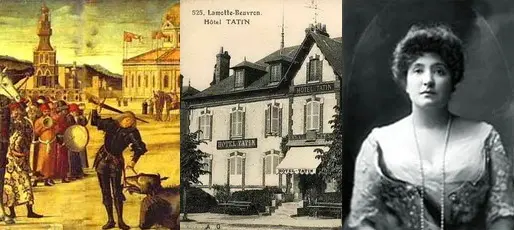
You might well have noticed that there are recipes involving names that have been so overused (often for any old thing) that they have almost become common nouns.
21 K 4.4/5 (20 reviews)
Keywords for this post:RecipeNameTatinCarpaccioMelbaLast modified on: September 25th 2012
The painter, the restaurant owners and the opera singer
Here are three examples that you can easily find on the menus of certain restaurants.
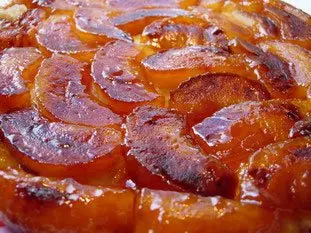 Normally it 's: A delicious tart with caramelized apples baked upside down (the pastry is on top) and turned upside down when serving.
Normally it 's: A delicious tart with caramelized apples baked upside down (the pastry is on top) and turned upside down when serving.
 Normally it's: A peach melba, a bowl of vanilla ice cream, raspberry coulis, poached peach, praline almond paste and whipped cream.
Normally it's: A peach melba, a bowl of vanilla ice cream, raspberry coulis, poached peach, praline almond paste and whipped cream.
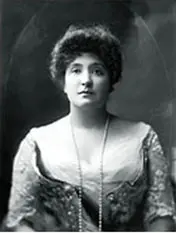 From: From the name of a famous Australian singer of the late 19th century, Nellie Melba, for whom the great chef Alain Escoffier invented this dessert.And often it's: Anything served with vanilla ice cream and Chantilly cream, like: Strawberries Melba, Pears Melba, etc.
From: From the name of a famous Australian singer of the late 19th century, Nellie Melba, for whom the great chef Alain Escoffier invented this dessert.And often it's: Anything served with vanilla ice cream and Chantilly cream, like: Strawberries Melba, Pears Melba, etc.
Of course, you can have fun combining them all... " Fraises Melba et leur carpaccio de poires Tatin": In a bowl, a base of vanilla ice cream, a layer of thin slices of caramelized pears, a circle of crisp shortcrust pastry, diced strawberries and Chantilly cream.
But... it looks good too!
Carpaccio
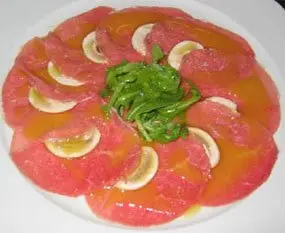 Normally a dish of raw beef, sliced very, very thinly, seasoned, covered with a light film of olive oil, and often served "on the plate".
Normally a dish of raw beef, sliced very, very thinly, seasoned, covered with a light film of olive oil, and often served "on the plate".
 It comes from: From the name of Vittore Carpaccio, a Venetian Renaissance painter famous for the reds and browns of his paintings, red as beef. Some even claim that he was inspired by his painting "The Triumph of St. George".
It comes from: From the name of Vittore Carpaccio, a Venetian Renaissance painter famous for the reds and browns of his paintings, red as beef. Some even claim that he was inspired by his painting "The Triumph of St. George".
Tatin
 Normally it 's: A delicious tart with caramelized apples baked upside down (the pastry is on top) and turned upside down when serving.
Normally it 's: A delicious tart with caramelized apples baked upside down (the pastry is on top) and turned upside down when serving.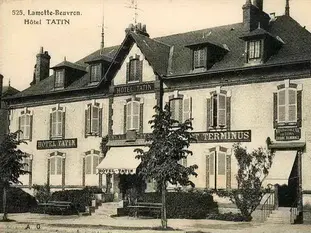 It comes from: From the name of the Tatin sisters, restaurateurs in La Motte-Beuvron, France, who invented this dessert in the early 20th century.
It comes from: From the name of the Tatin sisters, restaurateurs in La Motte-Beuvron, France, who invented this dessert in the early 20th century.
Melba
 Normally it's: A peach melba, a bowl of vanilla ice cream, raspberry coulis, poached peach, praline almond paste and whipped cream.
Normally it's: A peach melba, a bowl of vanilla ice cream, raspberry coulis, poached peach, praline almond paste and whipped cream.  From: From the name of a famous Australian singer of the late 19th century, Nellie Melba, for whom the great chef Alain Escoffier invented this dessert.And often it's: Anything served with vanilla ice cream and Chantilly cream, like: Strawberries Melba, Pears Melba, etc.
From: From the name of a famous Australian singer of the late 19th century, Nellie Melba, for whom the great chef Alain Escoffier invented this dessert.And often it's: Anything served with vanilla ice cream and Chantilly cream, like: Strawberries Melba, Pears Melba, etc.And?
Well, I've mentioned the most common, it seems, in French, but you'll notice that it's often linked to a proper noun.Of course, you can have fun combining them all... " Fraises Melba et leur carpaccio de poires Tatin": In a bowl, a base of vanilla ice cream, a layer of thin slices of caramelized pears, a circle of crisp shortcrust pastry, diced strawberries and Chantilly cream.
But... it looks good too!
Lasts posts
Butter vs. grease
We often read in a recipe where a pastry is put into a mould that, just before pouring, the mould should be buttered or greased. But what's the difference between these 2 terms?December 1st 20254265
Getting out of the fridge early
Very often when you're cooking, you need to take food or preparations out of the fridge, to use them in the recipe in progress. There's nothing tricky about this: you just take them out of the fridge and use them, usually immediately, in the recipe. But is this really a good method?November 24th 20258905
Who's making the croissants?
When you look at a bakery from the outside, you naturally think that in the bakery, the bakers make the bread, and in the laboratory, the pastry chefs make the cakes. It's very often like that, with each of these professions having quite different ways of working, but sometimes there's also one...November 23th 2025787
Oven height
When we put a dish or cake in the oven, we naturally tend to put it on the middle shelf, and that's what we usually do. But in some cases, this position and height can be a little tricky, so let's find out why.October 8th 20252,3615
The importance of sieving
In recipes that use a fine powder (flour, powdered sugar, etc.), you'll often see the advice to sift before using it. To sift is to pass the powder in question through a sieve (a very fine strainer) before incorporating it into your recipe. It's often advice, but is it really useful?September 3rd 20257,2923
Other pages you may also like
85 grams of eggs?
Some time ago, I already spoke to you about the difference between baking and pastry-making, I emphasized, among other things, the precision of pastry-making which requires grams, cm, degrees and minutes. That's why, on the one hand, you have baking and cooking, where a certain tolerance is...November 26th 201856 K4.6
How to break eggs properly?
It is a very common gesture in pastry, bakery and of course cooking: breaking eggs to incorporate them into a recipe. You have eggs (which professionals call "shell eggs" to differentiate them from liquid eggs in cartons or cans), and you must break them to incorporate the contents into your...June 26th 202115 K4.8
Creams in pastry
In this post, I propose you to make a small tour of the different creams in pastry. If you like to make them at home, you have already noticed the many creams that exist for the different desserts: Chantilly, custard, diplomat, Bavarian, etc. etc. Each one more delicious than the other, they...March 12th 202214 K4.5
Beans in primeur
As I write this, it is the beginning of the short season for fresh beans. If you've never made them before and you're just starting out (and that's a great idea) you'll find that it's a bit time consuming to prepare, you have to shell them once, remove the beans, scald them to remove the skin (and...June 4th 202214 K
Fried potatoes or fried mash?
In cooking there are a lot of dishes that appear to be extremely simple but which can actually prove to be very tricky. Amongst those that I'm aware of having this reputation are omelette and fried potatoes.February 6th 201125 K4.5
Post a comment or question
Follow this page
If you are interested in this page, you can "follow" it, by entering your email address here. You will then receive a notification immediately each time the page is modified or a new comment is added. Please note that you will need to confirm this following.
Note: We'll never share your e-mail address with anyone else.
Alternatively: you can subscribe to the mailing list of cooling-ez.com , you will receive a e-mail for each new recipe published on the site.









